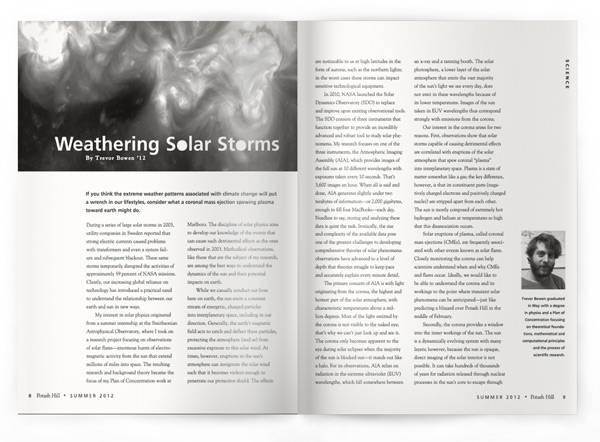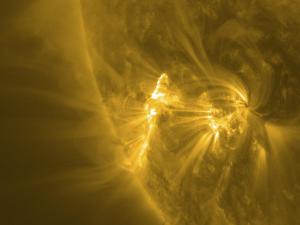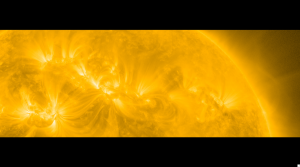
By Trevor Bowen ‘12
If you think the extreme weather patterns associated with climate change will put a wrench in our lifestyles, consider what a coronal mass ejection spewing plasma toward earth might do.
During a series of large solar storms in 2003, utility companies in Sweden reported that strong electric currents caused problems with transformers and even a system failure and subsequent blackout. These same storms temporarily disrupted the activities of approximately 59 percent of NASA missions. Clearly, our increasing global reliance on technology has introduced a practical need to understand the relationship between our earth and sun in new ways.
My interest in solar physics originated from a summer internship at the Smithsonian Astrophysical Observatory, where I took on a research project focusing on observations of solar flares—enormous bursts of electromagnetic activity from the sun that extend millions of miles into space. The resulting research and background theory became the focus of my Plan of Concentration work at Marlboro. The discipline of solar physics aims to develop our knowledge of the events that can cause such detrimental effects as the ones observed in 2003. Methodical observations, like those that are the subject of my research, are among the best ways to understand the dynamics of the sun and their potential impacts on earth.
 While we casually conduct our lives here on earth, the sun emits a constant stream of energetic, charged particles into interplanetary space, including in our direction. Generally, the earth’s magnetic field acts to catch and deflect these particles, protecting the atmosphere (and us) from excessive exposure to this solar wind. At times, however, eruptions in the sun’s atmosphere can invigorate the solar wind such that it becomes violent enough to penetrate our protective shield. The effects are noticeable to us at high latitudes in the form of auroras, such as the northern lights; in the worst cases these storms can impact sensitive technological equipment.
While we casually conduct our lives here on earth, the sun emits a constant stream of energetic, charged particles into interplanetary space, including in our direction. Generally, the earth’s magnetic field acts to catch and deflect these particles, protecting the atmosphere (and us) from excessive exposure to this solar wind. At times, however, eruptions in the sun’s atmosphere can invigorate the solar wind such that it becomes violent enough to penetrate our protective shield. The effects are noticeable to us at high latitudes in the form of auroras, such as the northern lights; in the worst cases these storms can impact sensitive technological equipment.
In 2010, NASA launched the Solar Dynamics Observatory (SDO) to replace and improve upon existing observational tools. The SDO consists of three instruments that function together to provide an incredibly advanced and robust tool to study solar phenomena. My research focuses on one of the three instruments, the Atmospheric Imaging Assembly (AIA), which provides images of the full sun at 10 different wavelengths with exposures taken every 10 seconds. That’s 3,600 images an hour. When all is said and done, AIA generates slightly under two terabytes of information—or 2,000 gigabytes, enough to fill four MacBooks—each day. Needless to say, storing and analyzing these data is quite the task. Ironically, the size and complexity of the available data pose one of the greatest challenges to developing comprehensive theories of solar phenomena: observations have advanced to a level of depth that theories struggle to keep pace and accurately explain every minute detail.
The primary concern of AIA is with light originating from the corona, the highest and hottest part of the solar atmosphere, with characteristic temperatures above a million degrees. Most of the light emitted by the corona is not visible to the naked eye; that’s why we can’t just look up and see it. The corona only becomes apparent to the eye during solar eclipses when the majority of the sun is blocked out—it stands out like a halo. For its observations, AIA relies on radiation in the extreme ultraviolet (EUV) wavelengths, which fall somewhere between an x-ray and a tanning booth. The solar photosphere, a lower layer of the solar atmosphere that emits the vast majority of the sun’s light we see every day, does not emit in these wavelengths because of its lower temperatures. Images of the sun taken in EUV wavelengths thus correspond strongly with emissions from the corona.
 Our interest in the corona arises for two reasons. First, observations show that solar storms capable of causing detrimental effects are correlated with eruptions of the solar atmosphere that spew coronal “plasma” into interplanetary space. Plasma is a state of matter somewhat like a gas; the key difference, however, is that its constituent parts (negatively charged electrons and positively charged nuclei) are stripped apart from each other. The sun is mostly composed of extremely hot hydrogen and helium at temperatures so high that this disassociation occurs.
Our interest in the corona arises for two reasons. First, observations show that solar storms capable of causing detrimental effects are correlated with eruptions of the solar atmosphere that spew coronal “plasma” into interplanetary space. Plasma is a state of matter somewhat like a gas; the key difference, however, is that its constituent parts (negatively charged electrons and positively charged nuclei) are stripped apart from each other. The sun is mostly composed of extremely hot hydrogen and helium at temperatures so high that this disassociation occurs.
Solar eruptions of plasma, called coronal mass ejections (CMEs), are frequently associated with other events known as solar flares. Closely monitoring the corona can help scientists understand when and why CMEs and flares occur. Ideally, we would like to be able to understand the corona and its workings to the point where transient solar phenomena can be anticipated—just like predicting a blizzard over Potash Hill in the middle of February.
Secondly, the corona provides a window into the inner workings of the sun. The sun is a dynamically evolving system with many layers; however, because the sun is opaque, direct imaging of the solar interior is not possible. It can take hundreds of thousands of years for radiation released through nuclear processes in the sun’s core to escape through its surface. Thus, scientists have historically had to work backwards from observations of the solar surface and atmosphere to study the nature of those interior physical processes. Our understanding of the solar magnetic field, for example, is primarily built on observations of the solar surface.
Magnetic fields are the primary culprits in most solar activity, and particularly relevant to our discussion of coronal eruptions. Essentially, the interior of the sun is made of free charged particles, or plasma as mentioned above. Like the earth, the sun rotates on its axis; accordingly, this rotation requires the motion of a huge mass of charged particles. One of the first principles in dealing with magnetism is that moving charges create magnetic fields. In the case of the sun, the massive amounts of moving charges create massive magnetic fields; this effect is called the solar dynamo. Over time, this magnetic field can bubble up through the solar surface into the atmosphere through convective processes—analogous to a single spaghetti noodle boiling up to the top of a pot of water.
 The catalyst for solar flares and CMEs is usually some sort of instability in the configuration of the magnetic field. In such cases, the magnetic field rapidly restructures itself to regain a stable footing, releasing immense amounts of energy in the process, which can in turn power a flare or CME. Understanding the physical conditions that lead up to eruptive events, such as the initial magnetic field configuration, is crucial to developing theories of these phenomena. Observations of the corona made by instruments like AIA make this science possible. Furthermore, these same observations provide a window into the workings of the solar interior, allowing for a complete and clear scientific narrative of our sun.
The catalyst for solar flares and CMEs is usually some sort of instability in the configuration of the magnetic field. In such cases, the magnetic field rapidly restructures itself to regain a stable footing, releasing immense amounts of energy in the process, which can in turn power a flare or CME. Understanding the physical conditions that lead up to eruptive events, such as the initial magnetic field configuration, is crucial to developing theories of these phenomena. Observations of the corona made by instruments like AIA make this science possible. Furthermore, these same observations provide a window into the workings of the solar interior, allowing for a complete and clear scientific narrative of our sun.
In early March 2012, we observed one of the largest flares to occur in the current solar cycle, certainly the largest since I have been collecting data. Associated with this flare was a significantly sized CME directed straight at earth, an event heralded by newspapers and other media that predicted disruptions to flights, GPS systems and power grids. Due to the magnetic orientation of the storm, the effects of the CME’s impact were minimized by earth’s magnetic field. However, this event demonstrates the reality of these eruptions and their potential impact on our world—in this case little more than a brief interruption in the weekly news cycle of a slow presidential primary season. If the magnetic field of the storm had been aligned slightly differently, the impact would have been quite noticeable.
Trevor Bowen graduated in May with a degree in physics and a Plan of Concentration focusing on theoretical foundations, mathematical and computational principles and the process of scientific research.
The art of programmed objects
 Aaron Evan-Browning ’12 used his Plan of Concentration to explore “the vocabularies of sculpture and computer science to make interactive objects.” “I see computer science more as a tool to make interesting things,” said Aaron. “I make things to satisfy my curiosity, to learn how things work and because I can’t help myself.” His impulsive creations resulted in a show in Drury Gallery that included, among other marvels, a set of computerized gnashing teeth and a children’s “Sing ‘n Smile Pals” toy, which he rewired in a process called circuit-bending to make sounds that would alarm most kids. Perhaps his most intriguing object is called “Eyebrow Switches,” a headband that creates seven different notes based on brow-bending facial expressions. “I have some of the best eyebrow control of anyone I know,” said Aaron.
Aaron Evan-Browning ’12 used his Plan of Concentration to explore “the vocabularies of sculpture and computer science to make interactive objects.” “I see computer science more as a tool to make interesting things,” said Aaron. “I make things to satisfy my curiosity, to learn how things work and because I can’t help myself.” His impulsive creations resulted in a show in Drury Gallery that included, among other marvels, a set of computerized gnashing teeth and a children’s “Sing ‘n Smile Pals” toy, which he rewired in a process called circuit-bending to make sounds that would alarm most kids. Perhaps his most intriguing object is called “Eyebrow Switches,” a headband that creates seven different notes based on brow-bending facial expressions. “I have some of the best eyebrow control of anyone I know,” said Aaron.

